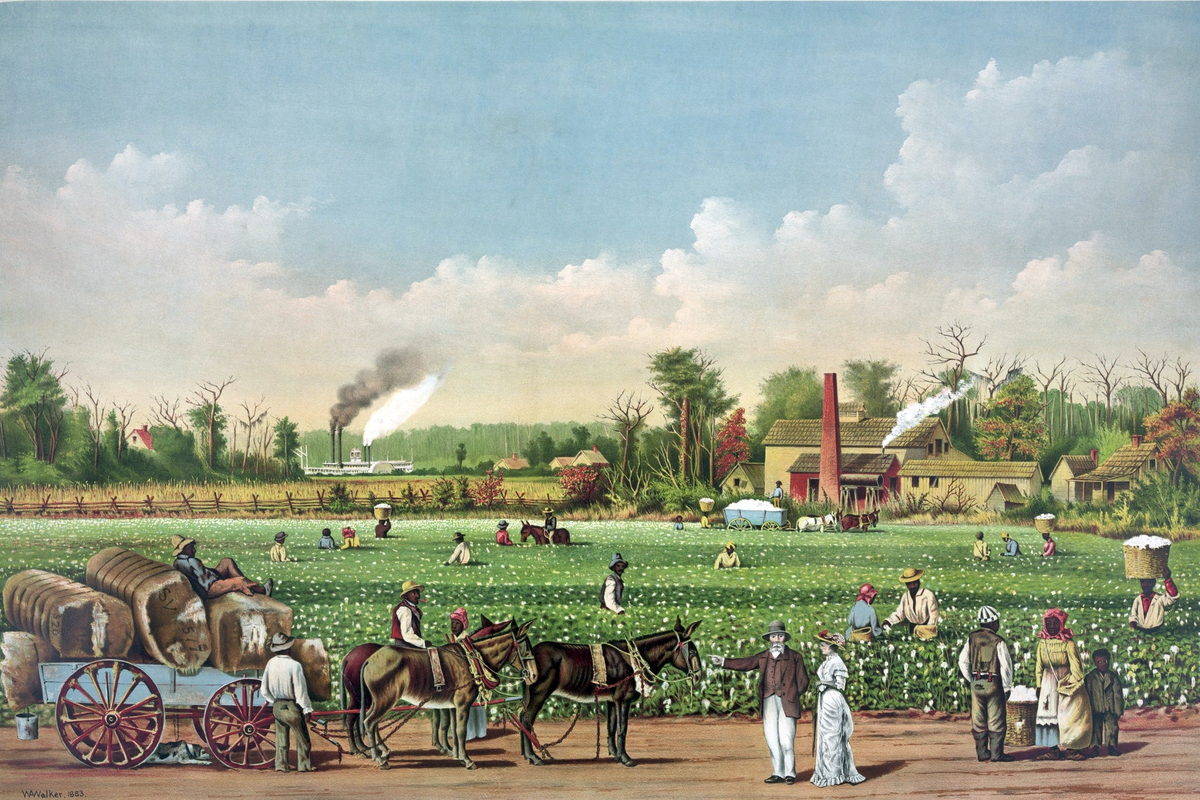The 1619 Project Resurrects King-Cotton Ideology of the Old South
“I say that cotton is king, and that he waves his scepter not only over these 33 states, but over the island of Great Britain and over continental Europe!”
So thundered Senator Louis T. Wigfall of Texas in December 1860, as an intended warning to those who doubted the economic viability of secessionism. Like many southerners, Wigfall subscribed to the “King Cotton” thesis: the belief that slave-produced cotton commanded a controlling position over the American economy and indeed the world’s commercial engines. Developed in the 1850s by political economist David Christy and championed by the radical pro-slavery politician James Henry Hammond, that argument was to be the nascent Confederacy’s trump card — an engine of global wealth in which all other economic activities were intertwined. Indeed, no nation would dare make war upon plantation slavery, for if the South suspended its production, in the words of Hammond, “we could bring the whole world to our feet.”
The strategy failed. The secessionists effectively self-embargoed what remained of their export crop in the wake of the war’s physical destruction and the Union’s blockade, and attempts to draw the European powers into the war on the Confederacy’s behalf were unsuccessful. King Cotton, in practice, proved nothing more than part self-delusion and part racist propaganda to rationalize the supposed economic necessity of chattel slavery. Modern empirical analysis has similarly debunked its claims: As Harvard economist Nathan Nunn has demonstrated, a strong negative relationship exists between the historical existence of slavery in a county or state and its level of income, persisting to the present day.
Yet despite its historical untenability, the economic reasoning behind King Cotton has undergone a surprising — perhaps unwitting — rehabilitation through a modern genre of scholarly works known as the new history of capitalism (NHC). While NHC historians reject the pro-slavery thrust of Wigfall and Hammond’s bluster, they recast slave-produced cotton as “not just as an integral part of American capitalism, but . . . its very essence,” to quote Harvard’s Sven Beckert. Cornell historian Ed Baptist goes even further, describing slavery as the indispensable causal driver behind America’s wealth today. Cotton production, he contends, was “absolutely necessary” for the Western world to break the “10,000-year Malthusian cycle of agriculture.”
And this same NHC literature provides the scholarly foundation of the ballyhooed New York Times’ 1619 Project — specifically, its foray into the economics of slavery. Guided by this rehabilitated version of King Cotton, Princeton sociologist Matthew Desmond enlists the horrors of the plantation system to launch a blistering attack on modern American capitalism.
Desmond projects slavery’s legacy onto a litany of tropes about rising inequality, the decline of labor-union power, environmental destruction, and the 2008 financial crisis. The intended message is clear: Modern capitalism carries with it the stain of slavery, and its putative excesses are proof of its continued brutality. It follows that only by abandoning the free market and embracing political redistribution will we ever atone for this tainted inheritance.
It’s not just the New York Times that uses NHC scholarship to distort the economic history of the U.S. At a congressional hearing earlier this summer, journalist Ta-Nehisi Coates enlisted another of Baptist’s claims to argue for reparations. “By 1836 more than $600 million, almost half of the economic activity in the United States, derived directly or indirectly from the cotton produced by the million-odd slaves,” Coates said.
This stunning statistic quickly became one of the most memorable sound bites of the occasion. It is also unambiguously false — the result of Baptist double- and triple-counting intermediate transactions from cotton production to artificially increase its economic share. Through an elementary accounting error, Baptist had inflated the actual size of the cotton sector by almost tenfold. At approximately 5 to 6 percent of the antebellum economy, cotton did indeed constitute a major output, roughly comparable in size to the northern-dominated railroad sector. It was not, however, the commercial monarch of either Confederate fantasy or Baptist’s revisionism.
Dubious statistical claims and shoddy research practices are alarmingly common in the broader NHC literature. Those who rely on it repeat these mistakes. In the 1619 Project, Desmond uses another of Baptist’s stats to attribute a 400 percent increase in the daily yield of cotton-picking between 1800 and 1860 to the systematization of whipping and torture as a means of increasing production. This “calibrated torture” thesis forms the central claim of Baptist’s 2014 book The Half Has Never Been Told, purporting to show that slave-based production was a capitalistic enterprise at its core and, furthermore, that modern industrial-management techniques (the recording of daily outputs, the comparative tracking of employee productivity, the keeping of double-entry accounting books) take a page from the most evil chapter of American history.
Yet again, Baptist’s thesis is built on misinterpreted evidence — or perhaps intentional deception. He bases his argument on the empirical work of economists Alan Olmstead and Paul Rhode, who assembled decades of plantation records to study the growth in cotton-crop yields before the Civil War. Olmstead and Rhode discovered the same 400 percent increase in cotton-picking rates yet found a completely different cause: The yields grew primarily as a result of technological improvements to the crop from cross-breeding different strains of cotton seed.
Olmstead and Rhode published a stinging rebuke of Baptist’s work, showing empirically that cotton-picking yields tended to follow daily variations across the crop season, not Baptist’s posited use of a torture-enforced quota system. In addition to his faulty GDP statistics, they showed that Baptist severely overstated the amount of wealth tied up in slavery. “The upshot,” they note, “is that slaves represented an important share of U.S. wealth but not nearly as great as Baptist claimed.”
They also uncovered evidence of Baptist massaging the details of primary-source accounts such as slave narratives to bolster his thesis. This included adding words to slave testimonies and blending passages from disparate sources to change their meaning. These suspicious edits make accounts of the treatment of slaves appear more similar to modern-day managerial tactics.
The economists do not contest or downplay the violent reality of plantation life, acknowledging openly that the widespread “use of violence or the threat of violence increased slave output.” But they document several instances of Baptist playing fast and loose with the evidence, either to exaggerate the resemblance of chattel slavery to modern managerial practices or to inflate the size of the plantation system and treat it as the single dominant economic force in antebellum America.
Curiously, participants of the 1619 Project evince little awareness of the deep historical deficiencies in Baptist’s work or of similar problems among the other NHC scholars on whom they rest their case. When I asked Nikole Hannah-Jones, the project’s editor, about its repetition of erroneous and contested economic claims, she said, “Economists dispute a few of Baptist’s calculations but not the book itself nor its thesis.”
Really? Contrast that with Olmstead’s concluding assessment: “Edward Baptist’s study of capitalism and slavery is flawed beyond repair.” Or Wellesley economist Eric Hilt’s review essay, in which he identifies “specious arguments and failures of analytical reasoning” in the NHC literature and chastises the genre for the way its “neglect of insights from economic history often weakens its analysis and undermines its credibility as social criticism.” Or the observation by Stanley Engerman, who in his co-authored work Time on the Cross defined the modern field on the economics of slavery, that Baptist does not meaningfully engage with “the last decades of works concerning economic aspects of the slave economy,” many of which cut directly against his conclusions. Indeed, much of the self-asserted novelty of the NHC historians seems to reflect their own unfamiliarity with the economic literature on the same subject. And Baptist, to his discredit, has generally declined to answer the substantive criticisms of his work, even as his errors spread to wider audiences via the press.
Like the original “King Cotton” thesis, the NHC suffers from its own ideological disposition. Though one sought to prop up slavery in its own day and the other condemns it historically, both build their evidence by working backward from the preexisting conclusion of its economic vitality. Both then advance the simply false assertion that this economic vitality was the driving engine of the antebellum economy.The thrust of these exaggerations is to recast slavery as a distinctly capitalistic enterprise, which, in turn, services the 1619 Project’s political message. The worthy historical task of documenting the horrors of American slavery has been cynically repurposed into an ideological attack on free-market capitalism. But in a curious final twist, the “King Cotton” theorists of old would have likely balked at the decision by their latter-day inheritors to label plantation slavery a capitalistic enterprise. To the original pro-slavery theorists, the very free-market theories that Baptist and the New York Times indict were an existential threat. The philosophical doctrines we now know as capitalism were “tainted with abolition, and at war with our institutions,” to quote an 1857 tract by leading pro-slavery theorist George Fitzhugh, and for slavery to survive this attack, he said, the South must “throw Adam Smith, Say, Ricardo & Co., in the fire.”
Insofar as the 1619 Project seeks to teach American society about the horrific historical legacy of slavery, it is no small irony that a significant part of the project borrows from a historical literature that apparently envisions a similar future for Adam Smith’s heirs.
This piece originally ran in National Review











